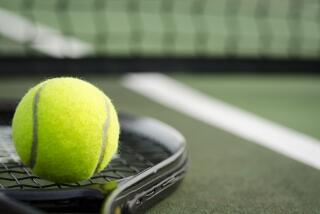Brown’s Concern Is With Courting the Kids : Pro Starts Youth Program in Effort to Make Tennis Available to Everyone
- Share via
Surely, after all these years, he must be tired of preaching his message to the masses.
Jim Brown is perched on the mount--actually, he’s sitting on a chair and talking on the telephone to deliver his pitch--doing what comes naturally.
“All we’re trying to do is get kids to play tennis,” he said.
This time, he was speaking to a tennis power broker in Tucson, trying to get a fledgling program off the ground there. But it doesn’t matter who is listening--whether it’s a prospective instructor, a reporter or an 8-year-old player--the message remains the same.
All rise and repeat after me: We must play tennis.
Tennis, anyone? For Brown, it’s more like, Tennis, everyone!
Nothing would make him happier than to see the nearly empty courts that dot Orange County these days, instead, teeming with parents and their children, whacking the ball back and forth. Actually, that’s giving him short shrift. Brown, the developer of the California Youth Tennis Foundation based in El Toro, wants to make tennis available to any youngster. Anywhere.
“The game of tennis has lost almost 50% (actually a 35% drop from 1977-1986) of its population,” said Brown, referring to a survey that the United States Tennis Assn. commissioned last year. “The game has to be promoted as a fun sport and more team-oriented. Tennis has always had this image of being a rich man’s sport and a sissy sport.”
Call him the Pied Piper of the tennis set, just trying to make it simple.
Back in 1977, when this all started, Brown was doing all right as a Marina del Rey teaching pro. He wasn’t rich, but giving lessons at $25 an hour seemed like a windfall. Brown observed, however, that not everyone interested in tennis could afford his services. So, Brown figured, if he wanted to be the best pro possible, he had to find, and help, those who had the talent and interest.
Los Angeles businessman Mark Chalek was there from the beginning, and according to Brown, he has kicked in almost $775,000 to fund the foundation.
Brown, now 39, started with a couple of vans, a mobile tennis unit if you will, and roamed the Southland giving free clinics in Ventura, San Bernardino, Los Angeles and Orange counties. Eventually, the mobile unit concept proved to be cost-prohibitive and Tennis Buddies took its current, community-based format.
Tennis Buddies now has a solid foothold throughout Southern California, including programs in such Orange County areas as Anaheim/Buena Park, El Toro, Fountain Valley, Irvine and San Juan Capistrano. Brown hopes to have programs in 20 states by this fall. At El Toro High School, 260 children have started playing this summer through the program, contrasted with 150 last year and 80 in 1985.
Brown’s intention was to create a tennis version of Little League, making the sport affordable for a middle-class family and teaching children the fundamentals in a group atmosphere. Kids, beginning at age 5, are grouped with others of comparable abilities.
“This is an entry-level program,” Brown said. “The kids work on a different stroke each day, and when they win so many points they move on to the next level.”
The program is structured so the player learns fundamentals before entering the traditional game. At El Toro, for instance, small groups of youngsters learned how to serve from the service line, rather than from the baseline. The player would attempt to hit a serve over the net and through a target, aiming for designated spots on the court.
Obviously, positive reinforcement is the key element in any learning process, and is even more important in tennis because of the difficult nature of the sport, according to Brown. After each session, a raffle is held and players have the chance to win T-shirts, headbands and other items.
Team and individual totals are kept, and players are rewarded with prizes for their progress.
Sessions run from 6 to 10 weeks. Brown tries to keep the cost parallel to the going rate of other youth programs, so the Tennis Buddies session can cost a parent from $35 to $45.
Already, he can point to some notable graduates of the Tennis Buddies program. Among the prominent are Fountain Valley’s Debbie Graham, runner-up at the USTA National Hardcourts 18-and-under event, and UC Irvine’s Darren Yates, who reached the NCAA doubles final with teammate Julian Barham last spring.
“That’s what really helped us get started, families like the Grahams and the Yateses,” Brown said. “Jim Graham (Debbie’s father) was one of our first local league directors. He helped hundreds of kids get started in the game for free. And Don Yates (Darren’s father) helped, too. These parents had (a) big effect on the program.”
Meanwhile, the parents are still helping, even if it just means picking up the balls.
“The way he (Brown) has this program scheduled, they (the children) are never going to get burned out,” said Linda Pierog of Laguna Niguel, whose two daughters were participating in the program at El Toro. “They can stay with this for a long time. They need a sport. Everybody needs a sport to make them more well-rounded. The girls need sports just like the boys do. This is the best thing for them.”
And, Brown figures, that sport should be tennis. For everyone.
The instructor, the preacher in Brown never completely disappears. At El Toro, he pointed at one promising young player named Spencer Lee, who was hitting some pretty acceptable serves.
“Hey, Spencer, how old are you?” Brown asked.
“Six years and one quarter,” Spencer answered.
Said Brown: “Great, now hit the ball to the opposite corner and not straight ahead, OK?”
More to Read
Go beyond the scoreboard
Get the latest on L.A.'s teams in the daily Sports Report newsletter.
You may occasionally receive promotional content from the Los Angeles Times.











